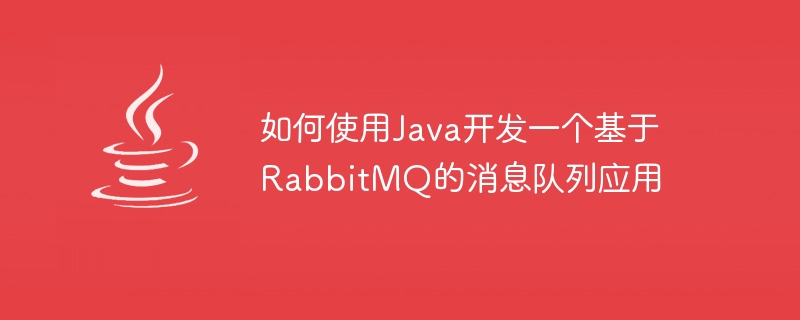

How to use Java to develop a message queue application based on RabbitMQ
Introduction:
Message queue is a communication mechanism commonly used in modern distributed systems. It can decouple the sender and receiver and improve the robustness and scalability of the system. RabbitMQ is a lightweight, reliable open source message queuing system based on the AMQP protocol and provides powerful messaging capabilities. This article will introduce how to use Java to develop a message queue application based on RabbitMQ, and come with specific code examples.
Step 1: Install and configure RabbitMQ
First, we need to install and configure RabbitMQ in the local environment. You can download the latest installation package from the official website of RabbitMQ and install and configure it according to the official documentation.
Step 2: Import the RabbitMQ client library
Before starting development, we need to import the RabbitMQ Java client library. You can add the following dependencies in the Maven or Gradle configuration file:
Maven dependencies:
<dependencies>
<dependency>
<groupId>com.rabbitmq</groupId>
<artifactId>amqp-client</artifactId>
<version>5.12.0</version>
</dependency>
</dependencies>Gradle dependencies:
dependencies {
implementation 'com.rabbitmq:amqp-client:5.12.0'
}Step 3: Create a producer
First, we need to create a producer (Publisher) to send messages to the RabbitMQ message queue. The following is a sample code:
import com.rabbitmq.client.ConnectionFactory;
import com.rabbitmq.client.Connection;
import com.rabbitmq.client.Channel;
public class Producer {
private final static String QUEUE_NAME = "hello";
public static void main(String[] args) throws Exception {
ConnectionFactory factory = new ConnectionFactory();
factory.setHost("localhost");
Connection connection = factory.newConnection();
Channel channel = connection.createChannel();
channel.queueDeclare(QUEUE_NAME, false, false, false, null);
String message = "Hello, RabbitMQ!";
channel.basicPublish("", QUEUE_NAME, null, message.getBytes());
System.out.println(" [x] Sent '" + message + "'");
channel.close();
connection.close();
}
}In the above code, we first create a connection factory (ConnectionFactory) and specify the host address of RabbitMQ. Then, we use the connection factory to create a connection (Connection), and then create a channel (Channel) through the connection. Next, we declare a message queue (queueDeclare) and send a message (basicPublish). Finally, we close the channel and connection.
Step 4: Create a consumer
Next, we need to create a consumer (Consumer) to receive and process messages obtained from the RabbitMQ queue. The following is a sample code:
import com.rabbitmq.client.*;
public class Consumer {
private final static String QUEUE_NAME = "hello";
public static void main(String[] args) throws Exception {
ConnectionFactory factory = new ConnectionFactory();
factory.setHost("localhost");
Connection connection = factory.newConnection();
Channel channel = connection.createChannel();
channel.queueDeclare(QUEUE_NAME, false, false, false, null);
Consumer consumer = new DefaultConsumer(channel) {
@Override
public void handleDelivery(String consumerTag, Envelope envelope, AMQP.BasicProperties properties, byte[] body) throws IOException {
String message = new String(body, "UTF-8");
System.out.println(" [x] Received '" + message + "'");
}
};
channel.basicConsume(QUEUE_NAME, true, consumer);
}
}In the above code, we first create a connection factory (ConnectionFactory) and specify the host address of RabbitMQ. Then, we use the connection factory to create a connection (Connection), and then create a channel (Channel) through the connection. Next, we declare a message queue (queueDeclare). Then, we create a consumer (DefaultConsumer) and override the handleDelivery method in it to process the received messages. Finally, we start the consumer by calling the basicConsume method.
Step 5: Run the application
Now, we have completed the development of producers and consumers. Before running the application, we need to ensure that RabbitMQ has been started in the local environment and the message queue has been created. Then, we run the main methods of the producer and consumer respectively to send and receive messages.
Summary:
Through the above steps, we successfully developed a message queue application based on RabbitMQ using Java. In actual development, we can configure other parameters according to our own needs, and perform performance optimization and exception handling.
Reference link:
The above is the detailed content of How to use Java to develop a message queue application based on RabbitMQ. For more information, please follow other related articles on the PHP Chinese website!